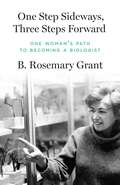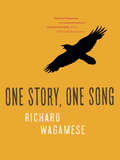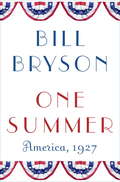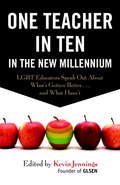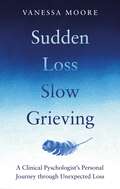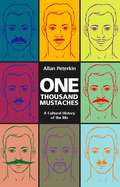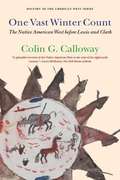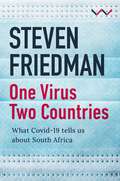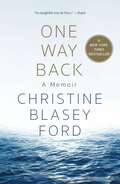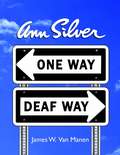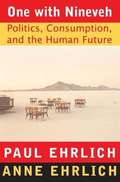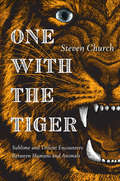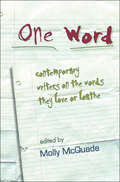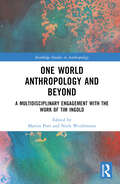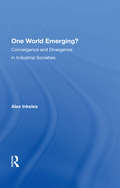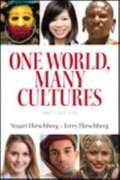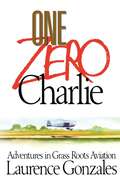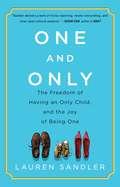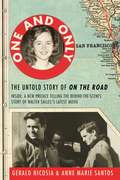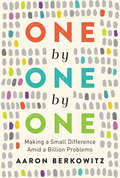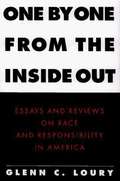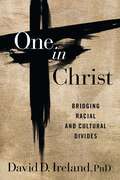- Table View
- List View
One Step Sideways, Three Steps Forward: One Woman’s Path to Becoming a Biologist
by B. Rosemary GrantThe story of the unorthodox and inspiring life and career of a pioneering biologist Scientist Rosemary Grant&’s journey in life has involved detours and sidesteps—not the shortest or the straightest of paths, but one that has led her to the top of evolutionary biology. In this engaging and moving book, Grant tells the story of her life and career—from her childhood love of nature in England&’s Lake District to an undergraduate education at the University of Edinburgh through a swerve to Canada and teaching, followed by marriage, children, a PhD at age forty-nine, and her life&’s work with Darwin&’s finches in the Galápagos islands. Grant&’s unorthodox career is one woman&’s solution to the problem of combining professional life as a field biologist with raising a family.Grant describes her youthful interest in fossils, which inspired her to imagine another world, distant yet connected in time—and which anticipated her later work in evolutionary biology. She and her husband, Peter Grant, visited the Galápagos archipelago annually for forty years, tracking the fates of the finches on the small, uninhabited island of Daphne Major. Their work has profoundly altered our understanding of how a group of eighteen species has diversified from a single ancestral species, demonstrating that evolution by natural selection can be observed and interpreted in an entirely natural environment. Grant&’s story shows the rewards of following a winding path and the joy of working closely with a partner, sharing ideas, disappointments, and successes.
One Story, One Song
by Richard WagameseA new collection of warm, wise and inspiring stories from the author of the bestselling One Native Life.Since its publication in 2008, readers and reviewers have embraced Richard Wagamese's One Native Life. "In quiet tones and luminous language," wrote the Winnipeg Free Press, "Wagamese shares his hurts and joys, inviting readers to find the ways in which they are joined to him and to consider how they might be joined to others."In this new book, Richard Wagamese again invites readers to accompany him on his travels. This time his focus is on stories: how they shape us, how they empower us, how they change our lives. Ancient and contemporary, cultural and spiritual, funny and sad, the tales are grouped according to the four essential principles Ojibway traditional teachers sought to impart: humility, trust, introspection and wisdom.
One Summer: America, 1927 (Bryson Ser. #2)
by Bill BrysonA Chicago Tribune Noteworthy BookA GoodReads Reader's ChoiceIn One Summer Bill Bryson, one of our greatest and most beloved nonfiction writers, transports readers on a journey back to one amazing season in American life.The summer of 1927 began with one of the signature events of the twentieth century: on May 21, 1927, Charles Lindbergh became the first man to cross the Atlantic by plane nonstop, and when he landed in Le Bourget airfield near Paris, he ignited an explosion of worldwide rapture and instantly became the most famous person on the planet. Meanwhile, the titanically talented Babe Ruth was beginning his assault on the home run record, which would culminate on September 30 with his sixtieth blast, one of the most resonant and durable records in sports history. In between those dates a Queens housewife named Ruth Snyder and her corset-salesman lover garroted her husband, leading to a murder trial that became a huge tabloid sensation. Alvin &“Shipwreck&” Kelly sat atop a flagpole in Newark, New Jersey, for twelve days—a new record. The American South was clobbered by unprecedented rain and by flooding of the Mississippi basin, a great human disaster, the relief efforts for which were guided by the uncannily able and insufferably pompous Herbert Hoover. Calvin Coolidge interrupted an already leisurely presidency for an even more relaxing three-month vacation in the Black Hills of South Dakota. The gangster Al Capone tightened his grip on the illegal booze business through a gaudy and murderous reign of terror and municipal corruption. The first true &“talking picture,&” Al Jolson&’s The Jazz Singer, was filmed and forever changed the motion picture industry. The four most powerful central bankers on earth met in secret session on a Long Island estate and made a fateful decision that virtually guaranteed a future crash and depression. All this and much, much more transpired in that epochal summer of 1927, and Bill Bryson captures its outsized personalities, exciting events, and occasional just plain weirdness with his trademark vividness, eye for telling detail, and delicious humor. In that year America stepped out onto the world stage as the main event, and One Summer transforms it all into narrative nonfiction of the highest order.
One Teacher in Ten in the New Millennium
by Kevin JenningsTwenty completely new stories of negotiating the triumphs and challenges of being an LGBT educator in the twenty-first century For more than twenty years, the One Teacher in Ten series has served as an invaluable source of strength and inspiration for lesbian, gay, bisexual, and transgender educators. This all-new edition brings together stories from across America--and around the world--resulting in a rich tapestry of varied experiences. From a teacher who feels he must remain closeted in the comparative safety of New York City public schools to teachers who are out in places as far afield as South Africa and China, the teachers and school administrators in One Teacher in Ten in the New Millennium prove that LGBT educators are as diverse and complex as humanity itself. Voices largely absent from the first two editions--including transgender people, people of color, teachers working in rural districts, and educators from outside the United States--feature prominently in this new collection, providing a fuller and deeper understanding of the triumphs and challenges of being an LGBT teacher today.From the Trade Paperback edition.
One Thousand Days and One Cup of Tea: A Clinical Psychologist's Experience of Grief
by Vanessa MooreVanessa's husband Paul dies suddenly and tragically on their regular Sunday morning swim. How will she cope with her dilapidated house, her teenage children, the patients who depend on her? Will therapy help? Why do mysterious white feathers start appearing in unexpected places? Beautifully written and honestly relayed, Vanessa uses her professional skills to explore the many questions posed by unanticipated death, and to try to find a way forwards."This book is about a period of great loss in my life, a time when the tables were completely turned on me. I was a qualified therapist who suddenly found myself needing psychological therapy. I was a trained researcher who became my own research subject, as I tried to make sense of what was happening to me. I was an experienced manager who now struggled to manage the events taking place in my own life. Yet, throughout all this turmoil, my patients were always there, in the background, reminding me that there are many different ways to deal with loss and trauma and search for a way forwards." Vanessa Moore
One Thousand Days and One Cup of Tea: A Clinical Psychologists Experience of Grief
by Vanessa MooreVanessa's husband Paul dies suddenly and tragically on their regular Sunday morning swim. How will she cope with her dilapidated house, her teenage children, the patients who depend on her? Will therapy help? Why do mysterious white feathers start appearing in unexpected places? Beautifully written and honestly relayed, Vanessa uses her professional skills to explore the many questions posed by unanticipated death, and to try to find a way forwards."This book is about a period of great loss in my life, a time when the tables were completely turned on me. I was a qualified therapist who suddenly found myself needing psychological therapy. I was a trained researcher who became my own research subject, as I tried to make sense of what was happening to me. I was an experienced manager who now struggled to manage the events taking place in my own life. Yet, throughout all this turmoil, my patients were always there, in the background, reminding me that there are many different ways to deal with loss and trauma and search for a way forwards." Vanessa Moore
One Thousand Mustaches
by Allan PeterkinThe 'stache is back! After decades of being much maligned in Western culture, the mustache is enjoying a cultural renaissance, thanks to the annual phenomenon of Movember (the international campaign in which men grow facial hair during the month of November to raise funds for prostate cancer research; in 2011, 1.8 million men in fourteen countries participated), and the retro/modern mo's sported by the likes of Ryan Gosling, Ashton Kutcher, and James Franco. Shaving companies are offering new-fangled mustache groomers, and even Dr Seuss's mustachioed The Lorax has made a comeback.One Thousand Mustaches is both a lighthearted cultural history and an earnest style manual: it's the story of the 'stache through the ages and its manifestations in politics, war, movies, music, sports, and art, as well as information on various 'stache styles and how to grow and wear them with pride. The book also includes numerous photos and drawings throughout.Contemplating a handlebar or considering a Fu Manchu? Find them and more styles here in One Thousand Mustaches: a book for those with mo's, and those who love 'em.Allan Peterkin is the author of One Thousand Beards and co-author of The Bearded Gentleman.
One Vast Winter Count: The Native American West before Lewis and Clark
by Colin G. CallowayThe author offers an unparalleled glimpse at the lives of generations of Native people in a western land from their arrivals thousands of years ago, to the early years of nineteenth century.
One Virus, Two Countries: What COVID-19 Tells Us About South Africa
by Steven FriedmanHas South Africa ‘done well’ at limiting illness and deaths during the COVID-19 pandemic? Academic and political commentator, Steven Friedman, thinks not. While the country’s mainstream media believes it has, in his view the evidence tells another story. South Africa has experienced by far the most cases and deaths in Africa – at one point as many as the rest of the continent combined.One Virus, Two Countries: What Covid-19 tells us about South Africa offers a searing analysis of government and expert scientists’ responses to the pandemic. Friedman argues that South Africa is two societies in one – a ‘First World’ which resembles Western Europe and North America, and a ‘Third World’ which looks much like the rest of Africa or South Asia. The South African state, the media and the scientific community have largely tried to deal with the virus through a ‘First World’ lens in which much of the country was either invisible or a problem – not a partner. Friedman argues this approach prevented the country from responding in a way which would have protected most citizens. This is why case numbers and deaths are so high: South Africa has done worse than the rest of Africa not despite the fact that it has a ‘more developed’ health system, but because it does.One Virus, Two Countries is a controversial book that will rouse much needed debate about South Africa’s health and economic system in a context of serious inequality.
One Way Back: A Memoir
by Christine Blasey FordNow a New York Times bestseller"A blisteringly personal memoir...a thoughtful exploration of what it feels like to become a main character in a major American reckoning." —The Washington Post"An insightful tour de force." —PeopleOn September 27, 2018, Christine Blasey Ford testified before the Senate Judiciary Committee which was considering the nomination of Judge Brett Kavanaugh to the United States Supreme Court. She described an alleged sexual assault by the Supreme Court nominee that took place at a high school party in the 1980s. Her words and courage on that day provided some of the most credible and unforgettable testimony our country has ever witnessed. In One Way Back, Ford recounts the months she spent trying to get information into the right hands without exposing herself and her family to dangerous backlash. Drawing parallels to her life as a surfer, she explains the process of paddling out into unknown waters despite the risks and fears, knowing there is only one way back to shore. The book reveals riveting new details about the leadup to her testimony and its overwhelming aftermath and describes how she continues to navigate her way out of the storm.This is the real story behind the headlines and the soundbites, a complex, page-turning memoir of a scientist, a surfer, a mother, a patriot and an unlikely whistleblower. Ford’s experience shows that when one person steps forward to speak truth to power, she adds to a collective whole, causing "a ripple that might one day become a wave.”
One Way, Deaf Way
by James W. Van Manen Ann SilverTo say that Ann Silver is a remarkable person is to miss the mark. While barely 20 years old Ann Silver along with a few others started the Deaf Art Movement. By age 40 she had created an international symbol of sign language interpreting and had her design work published on over 2000 book covers. Five years later after rededicating her life to studio art Silver had completed over 150 pieces and defined a new art genre Deaf Pop Art. This book leads the reader through the life and art of this incredible Deaf artist.
One With Nineveh: Politics, Environment, and the Human Future
by Paul R. Ehrlich Anne H. Ehrlich"Through lucid explanations, telling anecdotes, and incisive analyses, the eminent scientists Paul Ehrlich and Anne Ehrlich here spotlight the three elephants in our global living room--rising consumption, increasing world population, and unchecked political and economic inequity--that together are increasingly shaping today's politics, undermining the planet's ability to sustain us, and determining humankind's future. The result is a book that brilliantly puts today's policy debates in a larger context and makes a compelling case for the critical discussions that we should be having." (From the book jacket.)
One With the Tiger: Sublime and Violent Encounters Between Humans and Animals
by Steven ChurchOn September 21, 2012, twenty-five year old David Villalobos purchased a pass for the Bronx Zoo and a ticket for a ride on the Bengali Express Monorail. Biding his time, he waited until the monorail was just near the enclosure of a four hundred pound Siberian tiger named Bashuta before leaping into it. They spent ten long minutes together in the tiger's cage before nature took its course, with one exception: The tiger did not kill him. David's only response: "It's a spiritual thing. I wanted to be at one with the tiger."One with The Tiger: On Savagery and Intimacy uses David's story, and other moments of violent encounters between humans and predators, to explore the line between human and animal. Exposing what the author defines as the "shared liminal space between peace and violence," Church posits that the animal is always encroaching on the civilization -and those seeking its wildness are in fact searching for an ecstatic moment that can define what it means to be human. Using examples from Timothy Treadwell to Mike Tyson, or such television icons as Grizzly Adams and The Incredible Hulk, Church shows how this ecstasy can seep its way into the less natural world of popular culture, proving time and again that each of us can be our own worst predator.
One Word Shapes a Nation: Integration Politics in Germany (German and European Studies #53)
by Johanna Schuster-CraigOne Word Shapes a Nation demonstrates that integration politics limit how immigrants, refugees, and their descendants can participate in German society and how Germans imagine their national future. By reconstructing recent polemic media scandals, re-interpreting historical narratives about migration after the Second World War, and conducting extensive fieldwork with social work organizations that implement “integrative” programs, Johanna Schuster-Craig explores the intersection between media, capital, nation-building, and human lives in contemporary German society. The book reveals that while anti-immigrant tropes are long-standing in German post-war history, integration is not the only potential model. Schuster-Craig argues that “integration politics” in Germany is defined by a selective approach to who qualifies as a citizen, as well as beliefs about German national identity that require assimilation to cultural values beyond mere naturalization. Drawing on media analysis of key public speeches and debates, historical analysis, and ethnographic observation and interviews, Schuster-Craig examines the nature and impact of an integrative apparatus. One Word Shapes a Nation ultimately asks what it would take to reimagine immigrant incorporation as a form of citizenship that applies to everyone.
One Word: Contemporary Writers on the Words They Love or Loathe
by Molly Mcquade"Readers will find that the words profiled here have a new trace of meaning, warmth, and a time-worn glow."-John Morse, publisher of Merriam-Webster, Inc.In One Word: Contemporary Writers on the Words They Love or Loathe, Molly McQuade asks the question all writers love to answer: what one word means the most to you, and why? Writers respond with a wild gallimaufry of their choosing, from ardor to bitchin' to thermostat to wrong to very. There is corn, not the vegetable but the idea, defining cultural generations; solmizate, meaning to sing an object into place; and delicious slang, such as darb and dassn't. Composed as expository or lyric essays, zinging one-liners, extended quips, jeremiads, etymological adventures, or fantastic romps, the writings address not only English words but also a select few from French, German, Japanese, Quechua, Basque, Igbo, and others. The result is like the best of meals: filled with color, personality, and pomp. There is something delightful and significant for every reader who picks up this wonderful book.Includes contributions by Albert Goldbarth, Forrest Gander, Brenda Hillman, Mimi Schwartz, Daisy Fried, Thylias Moss, Srikanth Reddy, Susan Bernofsky, Michael Martone, Cole Swensen, and more.
One World Anthropology and Beyond: A Multidisciplinary Engagement with the Work of Tim Ingold (Routledge Studies in Anthropology)
by Martin Porr Niels WeidtmannThis volume offers a multidisciplinary engagement with the work of Tim Ingold. Involved in a critical long-term exploration of the relationships between human beings, organisms, and their environment, Ingold has become one of the most influential, innovative, and prolific writers in anthropology in recent decades. His work transcends established academic and disciplinary boundaries and his thinking continues to have a significant impact on numerous areas of research and other intellectual and artistic spheres. The contributions to this book are drawn from several fields, including social anthropology, archaeology, rock art studies, philosophy, and science and technology studies. The chapters critically engage with Ingold’s approaches and ideas in relation to a variety of case studies that include the exploration of Australian rock art, electricity in Pakistan, Spanish farmhouses and sensory dimensions of educational practices. Emphasising the importance of dialogue and debate, there is also a response to the contributions by Tim Ingold himself. The volume will appeal to a wide range of audiences and provide new avenues of theoretically informed anthropological exploration into the many realities and expressions of human life.
One World Emerging? Convergence And Divergence In Industrial Societies: Convergence And Divergence In Industrial Societies
by Alex InkelesIn One World Emerging? Alex Inkeles clarifies the meaning of convergence in the social organization of modern societies, shows how it can be measured, and illustrates in detail the manner and degree of convergence across national boundaries. Inkeles assesses the extent to which convergence in institutional patterns is reflected in the emergence of more common attitudes, values, and daily behaviors in different national populations as individuals and communities engage with and respond to the standardizing pressures of national development and global modernization. One popular image of the probable condition of humanity in the twenty-first century anticipates a new Armageddon with all the great civilizations at war with each other. This model neglects a less dramatic but deeper-seated process of worldwide change in which national economic and political systems become more alike and populations worldwide come to adopt similar lifestyles and develop similar attitudes and values for daily living. Alex Inkeles penetrating analysis focuses on this process of convergence.In One World Emerging? Inkeles clarifies the meaning of convergence in the social organization of modern societies, shows how it can be measured, and illustrates in detail the manner and degree of convergence across national boundaries. Sensitive to evidence counter to the main trend, he gives close attention to the many instances in which national differences persist and nations and their populations diverge from a common path.At the national level, he compares and contrasts the modernization of the United States, Russia, China, and India. Focusing on particularly important institutions, he reviews the process of convergence in prestige hierarchies, the family, education, and communications. Capping the enterprise, Inkeles assesses the extent to which convergence in institutional patterns is reflected in the emergence of more common attitudes, values, and daily behaviors in different national populations as individuals and communitiesin North America, Europe, and increasingly in Asiaengage with and respond to the standardizing pressures of national development and global modernization.
One World Many Cultures (Ninth Edition)
by Stuart Hirschberg Terry HirschbergThe best of all possible worlds! This truly global multicultural reader features contemporary selections by sixty-one internationally acclaimed authors from twenty-six countries. These compelling readings explore cultural differences in relation to race, class, gender and nationality, challenging students to compare their experiences with those of others in radically different cultural circumstances. Thematic chapters explore cultural perspectives on human experiences around the globe; family life, adolescent relationships, gender roles, work, race and class conflicts, customs, rituals and values. A new chapter focuses on the role of food in different cultures.
One Zero Charlie
by Laurence GonzalesGalt Airport in northern Illinois is known to the people who fly out of it as "One-Zero-Charlie" (for its FAA designation as Airport 10C). This evocative excursion into a little-known part of the heart of America takes us to a place where a love of flying draws people together, and a fascination with its sheer exhilaration keeps them that way.
One and Only: The Freedom of Having an Only Child, and the Joy of Being One
by Lauren SandlerA funny, tough-minded case for being and having an only child, debunking the myths about only children and taking glory in the pleasures of singletons: “A swift and absorbing read…may change your mind and the national conversation” (Psychology Today).Journalist Lauren Sandler is an only child and the mother of one. After investigating what only children are really like and whether stopping at one child is an answer to reconciling motherhood and modernity, she learned a lot about herself—and a lot about our culture’s assumptions. In this heartfelt work, Sandler legitimizes a discussion about the larger societal costs of having more than one, which Jessica Grose in her review in The New Republic calls, “the vital part of the conversation that’s not being discussed in the chatter” surrounding parenting. Between the recession, the stresses of modern life, and the ecological dangers ahead, there are increasing pressures on parents to think seriously about singletons. Sandler considers the unique ways that singletons thrive, and why so many of their families are happier. One and Only examines these ideas, including what the rise of the single-child family means for our economies, our environment, and our freedom, leaving the reader “informed and sympathetic,” writes Nora Krug in the Washington Post. Through this journey, “Sandler delves deeply, thoughtfully, and often humorously into history, culture, politics, religion, race, economics, and of course, scientific research” writes Lori Gottlieb, The New York Times Book Review. “I couldn’t put it down,” says Randi Hutter Epstein in the Huffington Post. Sandler “isn’t proselytizing, she’s just stating it like it is. Seductively honest.” At the end, Sandler has quite possibly cracked the code of happiness, demonstrating that having just one may be the way to resolve our countless struggles with adulthood in the modern age.
One and Only: The Untold Story of On the Road and LuAnne Henderson, the Woman Who Started Jack Kerouac and Neal Cassady on Their Journey
by Gerald NicosiaBeloved by both Jack Kerouac and Neal Cassady, Lu Anne Henderson has never told her story. Lu Anne was a beautiful 15-year-old girl in Denver in 1945 when she met Neal, a fast-talking hurricane of male sexuality. The two married, and soon they were hanging out with a group of young would-be writers, including Jack Kerouac and Allen Ginsberg. But Neal and Jack initially didn't like each other. Lu Anne ended up loving them both, and she taught them how to love each other -- giving Kerouac material for one of the seminal novels of the 20th century, On the Road. One and Only traces the immense struggles of Lu Anne's life, from the split-up of her family during the Great Depression to the ravages of abusive men and a late-life heroin addiction. It shows how her life intertwined with Jack's and Neal's to the very end.
One by One by One: Making a Small Difference Amid a Billion Problems
by Aaron BerkowitzIn the spirit of Tracy Kidder’s Mountains Beyond Mountains, and joining the ranks of works by Bryan Stevenson, Matthew Desmond, Abraham Verghese and Oliver Sachs, the inspiring story of a young American neurologist’s struggle to make a difference in Haiti by treating one patient—a story of social justice, clashing cultures, and what it means to treat strangers as members of our family.Dr. Aaron Berkowitz had just finished his neurology training when he was sent to Haiti on his first assignment with Partners In Health. There, he meets Janel, a 23-year-old man with the largest brain tumor Berkowitz or any of his neurosurgeon colleagues at Harvard Medical School have ever seen. Determined to live up to Partners In Health’s mission statement “to bring the benefits of modern medical science to those most in need,” Berkowitz tries to save Janel’s life by bringing him back to Boston for a 12-hour surgery. In One by One by One, Berkowitz traces what he learns and grapples with as a young doctor trying to bridge the gap between one of the world’s richest countries and one of the world’s poorest to make the first big save of his medical career.As Janel and Berkowitz travel back and forth between the high-tech neurosurgical operating rooms of Harvard’s hospitals and Janel’s dirt-floored hut in rural Haiti, they face countless heart-wrenching twists and turns. Janel remains comatose for months after his surgery. It’s not clear he will recover enough to return to Haiti and be able to survive there. So he goes for a second brain surgery, a third, a fourth. Berkowitz brings the reader to the front lines of global humanitarian work as he struggles to overcome the challenges that arise when well-meaning intentions give rise to unintended consequences, when cultures and belief systems clash, and when it’s not clear what the right thing to do is, let alone the right way to do it. One by One by One is a gripping account of the triumphs, tragedies, and confusing spaces in between as an idealistic young doctor learns the hard but necessary lessons of living by the Haitian proverb tout moun se moun—every person is a person.
One by One from the Inside Out
by Glenn C. LouryA renowned African American intellectual reconsiders the problem of racial inequality, rejects the liberal-conservative dichotomy as an obstacle to real progress, and argues that racial problems require a greater willingness for people to hold themselves accountable for what they make of their lives.
One in Christ: Bridging Racial & Cultural Divides
by David D. IrelandDavid Ireland, pastor of a multiracial megachurch in New Jersey and diversity consultant to the NBA, equips Christians to usher in a new era of racial reconciliation in One in Christ. Racial disharmony is tearing communities apart, both inside and outside the church. But Jesus Christ is, and was, a great reconciler. Warmth, regard, and respect emanated from His person toward others---all others. Part of this allure was the fact Jesus was comfortable in His skin. This made others who approached Him comfortable in their skin. This quality fuels the deconstruction of walls---the tearing down of barriers that keep us apart. In One in Christ, Ireland shows us that this quality can be learned. In fact, at the cellular structure of Christianity is the ability to be cross-cultural. The Great Commission proclaims it. Jesus said, "Therefore, go and make disciples of all nations" (Matthew 28:19). The word nation is the Greek word ethnos, where we derive the English word ethnic. In essence, the last charge Jesus gave was for His followers to become cross-cultural ambassadors. This is not optional, Ireland says: We must each become racially accommodating.
One of Us: Conjoined Twins and the Future of Normal
by Alice Domurat DregerMust children born with socially challenging anatomies have their bodies changed because others cannot be expected to change their minds? One of Us views conjoined twinning and other "abnormalities" from the point of view of people living with such anatomies, and considers these issues within the larger historical context of anatomical politics. Anatomy matters, Alice Domurat Dreger tells us, because the senses we possess, the muscles we control, and the resources we require to keep our bodies alive limit and guide what we experience in any given context. Her deeply thought-provoking and compassionate work exposes the breadth and depth of that context--the extent of the social frame upon which we construct the "normal." In doing so, the book calls into question assumptions about anatomy and normality, and transforms our understanding of how we are all intricately and inextricably joined.
